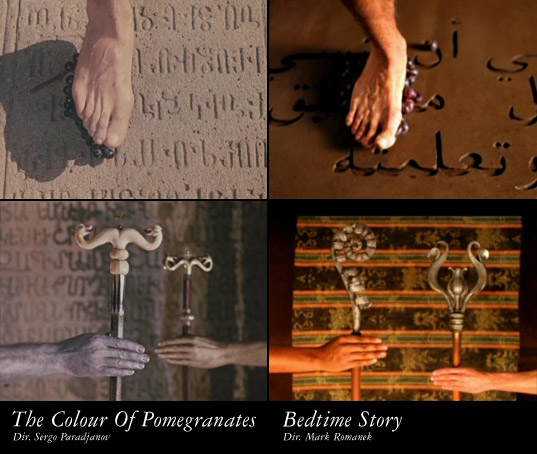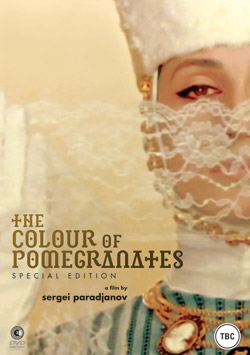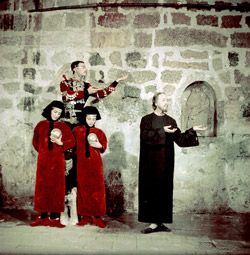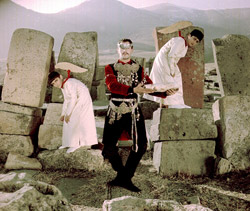
THE COLOUR OF POMEGRANATES (DVD)
Second Sight
Release date: August 29th, 2011
Certificate (UK): U
Running time: 70 minutes
Year of production: 1968
Country of origin: USSR
Original language: Georgian with English subtitles
Writer and director: Sergo Paradjanov
Composer: Tigran Mansuryan
Cast: Sofiko Chiaureli, Melkon Aleksanyan, Vilen Galstyan, Giorgi Gegechkori
There is only one fitting way to tell the life of a poet like Sayat Nova, and that’s through poetry itself.
Nova, from Armenia, lived from 1712 to 1795 and in between that time it’s believed that he composed thousands of poems and songs in his native language as well as Georgian, Persian and Arabic, including Love Song.
Like the 13th century Muslim poet Rumi, Nova’s work is both spiritual and full of expression, and with such a strong sense of divinity, it would seem that they’re written by the pen of God.
Armenian director Sergo Paradjanov abandoned the socialist realist style of filmmaking, which at the time was the only sanctioned art style in the USSR, in favour of his own unique style. In 1968 he took on the task of bringing Nova’s story to the screen. The Colour Of Pomegranates emerged as kaleidoscope of colours, textures, sounds, emotions…a myriad of exotic and timeless images.
It was poetry in motion and it captured key moments in Nova’s life from when he started work as a carpet weaver’s apprentice, then as a court minstrel, before entering the monastery where he would be killed by the Emperor of Persia’s army as it invaded Georgia.
Featuring many verses from Nova’s work and with music composed and performed by Tigran Mansuryan, The Colour Of Pomegranates is truly a like a dream I wished to never wake from.
It combines religious rituals and beautiful costumes to offer a vision of a place that this is both surreal, forgotten or just unknown and unimaginable to most of us now. There is so much attention to detail here that every scene is like an open dialogue between the director and the poet.
For those who claim it’s non-narrative, unconventional, or worse yet, label it “art-house” – a term like Avant-garde which is used and abused to describe anything people don’t understand and therefore do not like, it leaves me mystified. The art of storytelling is more present and alive here than in what is commonly considered conventional.
In a way The Colour Of Pomegranates reminds me not only of the surrealist artists of the early 20th century and Renaissance paintings but also of images from European folk tales dating back to early 18th century.
The film was censored and remained unseen for a number of years, but when it finally surfaced after being smuggled to the West, it rose to inspire many other filmmakers. For example, Mark Romanek recreated one of the scenes for Madonna’s 1994 music video “Bedtime Story” which has now been made part of the permanent collection of the Museum of Modern Art in New York City. See below for a comparison of two scenes from each of them.
- The World Is A Window: Making The Colour Of Pomegranates (1:15:58)
- Memories of Sayat Nova (30:21)
- Introduction By Daniel Bird (02:55)
- Commentary By Levon Abrahamyan
The Colour Of Pomegranates is a stunning piece of work with unforgettable images, mesmerising sounds and beautiful verses from Nova’s work. If we are to think of film like like a book, then Nova’s words couldn’t be more true than here “A book must be cherished and read, for a book is both life and soul”.

Directed by Robert Wise, The Haunting is about a group of people who spend a weekend in a haunted mansion. But what makes it gothic?
Another vigilante crime fighter takes to the streets in this short lived television series created by Tom Wheeler and starring David Lyons as a poorly disguised crusader.
With Agent Strahm dead, Hoffman gets to work framing him as Jigsaw’s accomplice. Meanwhile, a new game is set in motion which will reveal another piece of the puzzle.
The desolate setting does exactly the same as the Outback does for Australia in films such as Wolf Creek (2005). The harsh sounding wind adds to the tension.
With so many mythologies and superstitions to be inspired from, it’s disappointing that Mirrors 2 fails to catch an opportunity to tell something interesting.



















































































